|
 Tylopilus formosus Tylopilus formosus
BiostatusPresent in region - Indigenous. Non endemic
Images (click to enlarge)
Caption: Watercolour
Owner: G.M. Taylor | 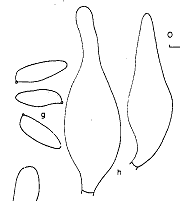
Caption: Fig. 10. Tylopilus formosus: g, spores; h, cystidia. | 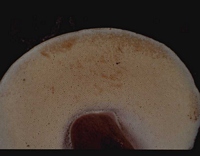
Owner: R.E. Beever | 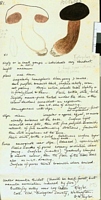
Caption: Watercolour
Owner: G.M. Taylor | 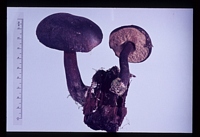
Caption: C-3755, Tylopilus formosus
Owner: Herb. PDD | 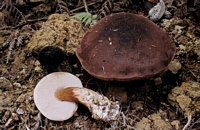
Caption: REB 1338
Owner: Ross Beever | 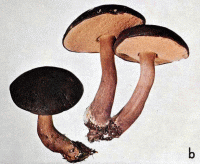
Caption: Fig. 6 - b, Tylopilus formosus (x 1/2) | 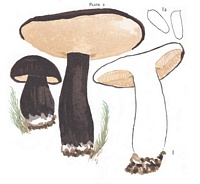
Caption: Plate 2: 1, Tylopilus formosus, nat. size; 1a, spores. x 2000: | 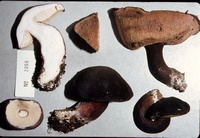
Caption: ZT2058
Owner: E. Horak: © Creative Commons Attribution-Noncommercial 3.0 New Zealand | 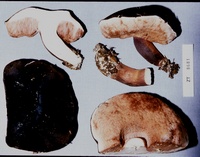
Caption: ZT8681
Owner: E. Horak: © Creative Commons Attribution-Noncommercial 3.0 New Zealand | 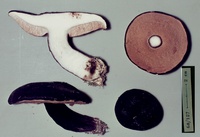
Caption: ZT68-127
Owner: E. Horak: © Creative Commons Attribution-Noncommercial 3.0 New Zealand | 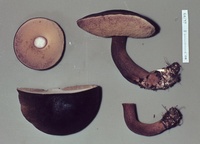
Caption: ZT68-037
Owner: E. Horak: © Creative Commons Attribution-Noncommercial 3.0 New Zealand | 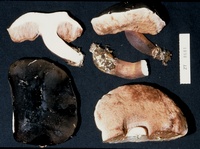
Caption: ZT8681
Owner: E. Horak: © Creative Commons Attribution-Noncommercial 3.0 New Zealand | 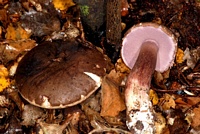
Owner: J.A. Cooper | 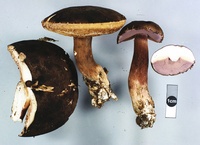
Owner: J.A. Cooper | 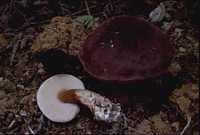
Owner: R.E. Beever | |
Article: Stevenson, G. (1962) [1961]. The Agaricales of New Zealand: I. Kew Bulletin 15(3): 381–385.
Description: Pileus 4-9 cm. diam., dry, dark blackish brown, velvety, margin inrolled, flesh white, firm, not changing colour when cut; pellicle of dermatocystidia 30 x 6-8meach containing droplets or granules of pigment, arranged in a loose palisade layer. Pores 0.5-1 mm. diam., tubes 3-6 mm. long, pale pink fawn, tube layer readily separable, depressed round the stipe. Stipe 4-8 X 1.5-3 cm., dark blackish brown, velvety, tapering upwards, white at base, flesh white and firm, surface of stipe without dermatocystidia of cap but with pigment in hyphal ends and some trichocystidia. Spores 10-11 X 3-4um, colourless, thin-walled, print practically colourless with a pink-fawn tinge, no cystidia seen.
Habitat: HABITAT: under Nothofagus solandri and N. fusca near Lake Rotoiti, Nelson, 5.3.1955, Stevenson. Dun Mt., Nelson, 12.4.1955, S. Poague. Milford Track, Otago, 25.1.1957, Stevenson. Silverstream, Wellington, 21.4.1958, H. Druce.
Article: McNabb, R.F.R. (1968). The Boletaceae of New Zealand. New Zealand Journal of Botany 6(2): 137-176 (http://www.rsnz.org/publish/abstracts.php).
Description: PILEUS: convex,
plano-convex or applanate, 6-15 cm diam., dry, velutinate, occasionally almost
subglabrous in areas at maturity, chocolate brown to dark brownish black, sometimes
with deep purplish tints; cuticle a trichodermium, composed of erect, branched,
septate hyphae 5.5-12 n diam.. Terminal cells acuminate or bluntly acuminate,
with dark brown contents, often becoming disorganised at maturity, and terminal
cells aggregated into tufts; margin entire, often extending beyond pores and
incurved, sterile. HYMENOPHORE: tubes to 16mm long, excavated around apex of
stipe, very occasionally adnate, ivory to fawn when young, becoming pallid brownish
orange at maturity; pores concolorous with tubes or slightly darker at maturity,
oval to irregularly angular, 0.5-1 mm diam.. STIPE: 5-11 cm long, tapering apically
to 2 cm diam., expanded basally to 3.5 cm diam., solid or slightly stuffed at
maturity, dry, finely granular to furfuraceous by aggregation of caulocystidia,
occasionally faintly reticulate at extreme apex, concolorous with pileus or
slightly paler apically, sometimes with deep purplish tints; flesh white; annulus
absent.
SPORES: spore print brownish orange with pink tints
(between Sayal Brown and Wood Brown); spores pallid stramineous, elliptic-subfusiform
to broadly elliptical, 9.8-14.2-(15) X 4-5.3 µm., smooth. HYMENIUM: basidia
hyaline, clavate, 21-33 X 7.5-11.5 µm., 4-spored; cystidia numerous, crowded
at tube mouths, hyaline or brownish, thin-walled, obclavate, lageniform or ventricose-rostrate,
37-67 X 10-16µm.. HYMENOPHORAL TRAMA: bilateral, of the Boletus subtype; clamp
connections absent. CONTEXT OF PILEUS: white, unchanging on exposure to air.
TASTE: extremely acrid and bitter. SMELL: not distinctive. CHEMICAL REACTIONS:
KOH and NH4OH on pileus and context of pileus—no reaction.
Habitat: HABITAT: Solitary, gregarious, or caespitose under native
broadleaved trees and shrubs.
Notes: The above description
differs from that of Stevenson in that cystidia are numerous and distinct, the
range in spore size is considerably greater, and the spore print is brownish
orange. The unchanging, bitter tasting context which does not stain yellow with
KOH indicates that Tylopilus formosus belongs in sect. Tylopilus
as defined by Singer (1962).
Field observations
strongly suggest that T. formosus is capable of forming mycorrhizal associations
with both Nothofagus and Leptospermum.
Tylopilus formosus may be recognised by the velutinate,
dark brownish-black pileus and stipe, pallid brownish-orange hymenophore, and
white, bitter tasting context.
Article: Gadgil, P.D. (in association with Dick, M.A.; Hood, I.A.; Pennycook, S.R.) (2005). Fungi on trees and shrubs in New Zealand. Fungi of New Zealand. Ngā Harore o Aotearoa 4: xi + 437 p. Hong Kong: Fungal Diversity Press.
Description: Type: Mycorrhizal Fungi; Description: Basidiomata pileate. Pileus chocolate brown to dark brownish black, 60–150 mm in diameter, convex to applanate, velutinate, dry; flesh white. Pore surface excavated around apex of stipe; tubes yellowish white becoming pale brownish orange at maturity, up to 16 mm long; pores concolorous with tubes, oval to irregularly angular, 0.5–1 mm in diameter. Stipe tapering towards the apex, concolorous with the pileus or slightly paler, finely granular, annulus absent, 50–110 mm long. Basidiospores elliptical, 0-septate, 10–14 × 4–6 μm, smooth, pale yellow.
DISTRIBUTION: Auckland, Wellington, Nelson, Buller, Mid Canterbury.
Distribution: Distribution: Auckland, Wellington, Nelson, Buller, Mid Canterbury.; 1st Record: McNabb (1968).
|